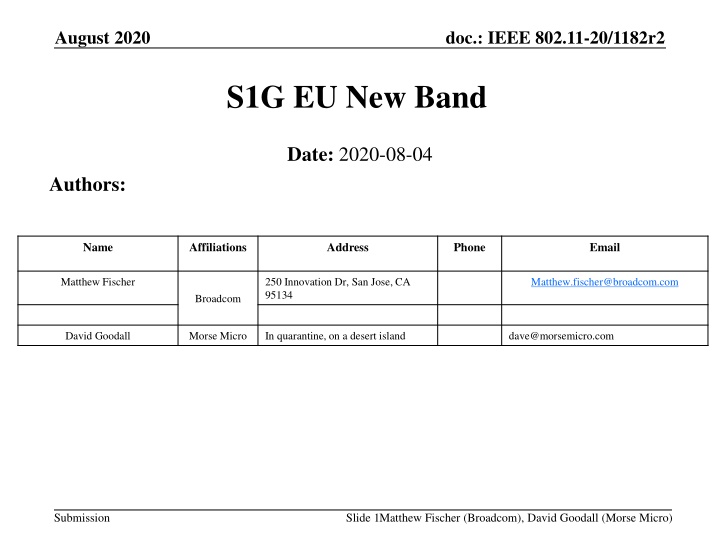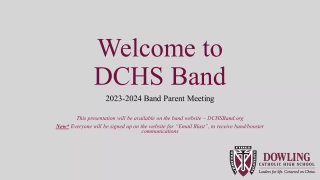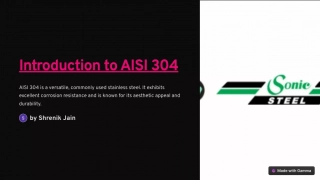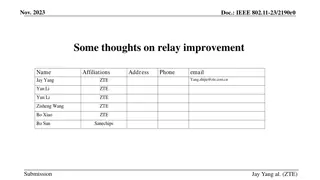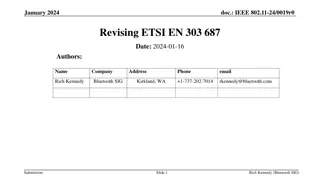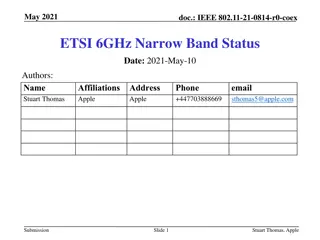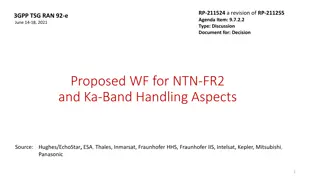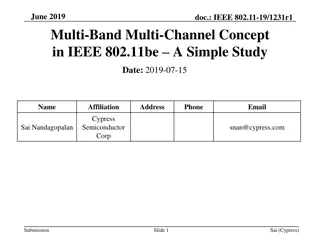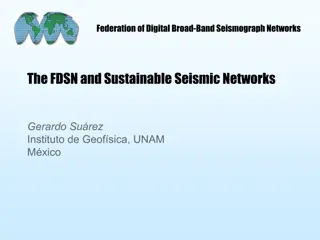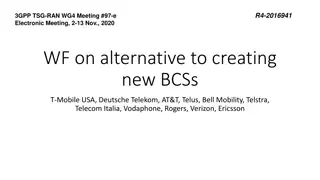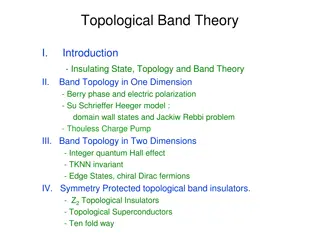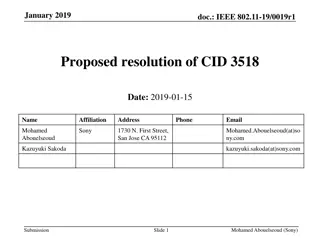S1G EU New Band
This document, dated August 2020, pertains to IEEE 802.11-20/1182r2S1G.EU, focusing on the introduction of a new band on August 4, 2020. Matthew Fischer from 250 Innovation Dr, San Jose, CA 95134, is among the authors.
Download Presentation

Please find below an Image/Link to download the presentation.
The content on the website is provided AS IS for your information and personal use only. It may not be sold, licensed, or shared on other websites without obtaining consent from the author.If you encounter any issues during the download, it is possible that the publisher has removed the file from their server.
You are allowed to download the files provided on this website for personal or commercial use, subject to the condition that they are used lawfully. All files are the property of their respective owners.
The content on the website is provided AS IS for your information and personal use only. It may not be sold, licensed, or shared on other websites without obtaining consent from the author.
E N D
Presentation Transcript
August 2020 doc.: IEEE 802.11-20/1182r2 S1G EU New Band Date: 2020-08-04 Authors: Name Affiliations Address Phone Email Matthew Fischer 250 Innovation Dr, San Jose, CA 95134 Matthew.fischer@broadcom.com Broadcom David Goodall Morse Micro In quarantine, on a desert island dave@morsemicro.com Submission Matthew Fischer (Broadcom), David Goodall (Morse Micro) Slide 1
August 2020 doc.: IEEE 802.11-20/1182r2 Abstract CID 4036 The EU has recently added a band suitable for use by S1G devices 1 MHz channels only These newly available channels should be included in the global channels listing in Annex E Table E-4 Global operating classes That table references Table E-5 S1G operating classes So this table also needs to be updated Submission Matthew Fischer (Broadcom), David Goodall (Morse Micro) Slide 2
August 2020 doc.: IEEE 802.11-20/1182r2 CID 4036 Proposed Resolution Revise TGmd editor to make changes shown in 11-20-1182r1 which add operating classes to the Annex E Global operating classes table and the Annex E S1G operating classes table to include the new band and channels Commen ter David Goodall Comment The 915.8 MHz to 919.4 MHz band has become available for use by S1G devices in Europe. Proposed Change Add an operating class for the new band available in Europe to table E-5. This will support 1 MHz channels only. It will also need a global operating class added to table E-4. CID Page 4382.00 E Clause 4036 CID 4036 Submission Matthew Fischer (Broadcom), David Goodall (Morse Micro) Slide 3
August 2020 doc.: IEEE 802.11-20/1182r2 New Channels The following channels are recently available in the EU, but are not included in the Global operating classes table in Annex E, nor in the S1G operating classes table in Annex E 1 MHz channels within the range: 915.8 919.4 MHz i.e. 3 or 4 channels, depending on where you start Submission Matthew Fischer (Broadcom), David Goodall (Morse Micro) Slide 4
August 2020 doc.: IEEE 802.11-20/1182r2 Existing European Spectrum 863-868 MHz EU 802.11ah devices are covered by the following: DECISION (EU) 2017/1483 (See References [2]) This document contains the Annex: Harmonised frequency bands and technical parameters for short-range devices with the legal requirements for the SRDs in the European Union. Band no Frequency band Category of short-range devices Transmit power limit/field strength limit/power density limit Additional parameters (channelling and/or channel access and occupation rules) Other usage restrictions Implementation deadline 84 863-868 MHz Wideband data transmission devices [16] 25 mW e.r.p. Techniques to access spectrum and mitigate interference that provide at least equivalent performance to the techniques described in harmonised standards adopted under Directive 2014/53/EU must be used. Bandwidth: 1 MHz. Duty cycle [vi]: 10 % for network access points [26] Duty cycle [vi]: 2,8 % otherwise This set of usage conditions is only available for wideband SRDs in data networks [26]. 1 January 2018 Submission Matthew Fischer (Broadcom), David Goodall (Morse Micro) Slide 5
August 2020 doc.: IEEE 802.11-20/1182r2 New spectrum 917.4-919.4 MHz EU 917.4 919.4 MHz covered by: DECISION (EU) 2018/1538 (See References [3]) See band 2 for wideband data transmission devices Same conditions as for 863-868MHz Submission Matthew Fischer (Broadcom), David Goodall (Morse Micro) Slide 6
August 2020 doc.: IEEE 802.11-20/1182r2 CID 4036 Updates CID 4036 should be revised for a couple of reasons There is not yet a decision document for 915.8-917.4 MHz So only two new channels in 917.4 919.4 MHz can be added at this time This is counter to the request within CID 4036, which anticipated 3 or 4 available channels AND The current 2MHz channels in 863-868 MHz are no longer allowed by the latest applicable decision document for that band and therefore, should be removed Propose to remove S1G operating class 7 in Table E-5 Attempt to reuse S1G operating class 7 for the new band might cause backwards compatibility problems Submission Matthew Fischer (Broadcom), David Goodall (Morse Micro) Slide 7
August 2020 doc.: IEEE 802.11-20/1182r2 Example Of S1G Operating Classes (1) S1G Table references An existing example of S1G classes: Operating class Nonglobal operating class(es) Channel starting frequency (GHz) Channel spacing (MHz) Channel set Channel center frequency index Behavior limits set 71 E-5-4, E-5- 25, E-5-29 0.902 8 - Reserved - 72 E-5-5 0.902 16 - Reserved - 73 E-5-8 0.9165 1 - Reserved - 74 E-5-14 0.9175 1 - Reserved - Table E-4 Global operating classes Note that Channel Set is not provided directly (in contrast to non-S1G cases) Submission Matthew Fischer (Broadcom), David Goodall (Morse Micro) Slide 8
August 2020 doc.: IEEE 802.11-20/1182r2 Determining S1G Channel Numbers 23.3.14 Channelization Extracted text: Channel center frequency determination: fc= ChannelStartingFrequency + fseparation x ChannelCenterFrequencyIndex fseparation has the value 0.5 MHz ChannelStartingFrequency and ChannelCenterFrequencyIndex are region and operating class specific and given in Annex E. The global table entries show reserved so you need to consult Table E-5 S1G operating class table See next slide Submission Matthew Fischer (Broadcom), David Goodall (Morse Micro) Slide 9
August 2020 doc.: IEEE 802.11-20/1182r2 Example Of S1G Operating Classes (2) S1G Channel Numbers! How to find S1G channels: S1G Global operating Class (See Table E-4) Channel starting frequency (GHz) Channel spacing (MHz) Channel center frequency index CCA Level Classification Behavior limits set operating class 4 (United States) 71 0.902 8 44 Type 1 (920-928 MHz) - 12, 28 Type 2 (904-920 MHz) 5 (United States) 72 0.902 16 20 Type 2 (904-920 MHz) - 6 (Europe) 66 0.863 1 1, 3, 5, 7, 9 Type 1 (863-868 MHz) - 7 (Europe) 67 0.863 2 2, 6 Type 1 (863-868 MHz) - Table E-5 S1G operating classes Currently, only S1G operating classes 6 and 7 are defined for the EU Submission Matthew Fischer (Broadcom), David Goodall (Morse Micro) Slide 10
August 2020 doc.: IEEE 802.11-20/1182r2 Where Does the New EU Band Fit? (1) Only two S1G operating classes currently defined for the EU They share a starting frequency which is different from the new one They share a channel number system/set/organization (with each other) Two classes exist because channel widths are different: 1 v 2 MHz As noted further above, 2 MHz should be removed Some countries have multiple starting frequencies, i.e. bands China, Singapore Both of them restart the numbering for each band (i.e. class) See next slide Slide 11 Submission Matthew Fischer (Broadcom), David Goodall (Morse Micro)
August 2020 doc.: IEEE 802.11-20/1182r2 Example Of S1G Operating Classes (3) Table E-5 - Multiple bands for Singapore and China: S1G Global operating Class (See Table E-4) Channel starting frequency (GHz) Channel spacing (MHz) Channel center frequency index CCA Level Classification Behavior limits set operating class 17 66 0.863 1 7, 9, 11 Type 1 (866-869 MHz) - (Singapore) 18 68 0.902 1 37, 39, 41, 43, 45 Type 2 (920-925 MHz) - (Singapore) 9 (China) 61 0.755 1 1, 3, 5, 7, 9, 11, 13, 15, 17, 19, 21, 23, 25, 27, 29, 31, 33, 35, 37, 39, 41, 43, 45, 47 Type 1 (755-779 MHz) - 10 (China) 62 0.779 1 1, 3, 5, 7, 9, 11, 13, 15 Type 1 (779-787 MHz) - Submission Matthew Fischer (Broadcom), David Goodall (Morse Micro) Slide 12
August 2020 doc.: IEEE 802.11-20/1182r2 Where Does the New Band Fit? (2) EU needs a new starting frequency (i.e. new band ) Based on existing examples: E.g starting channel frequency 901.4 MHz to allow band to grow down from 917.4-919.4 MHz as well as up, and less chance of repeating the channel index in EU bands (to save confusion) 917.4-919.4 MHz can accommodate two 1 MHz wide channels with centers on 0.9 MOD 1 MHz frequencies Center of channel with channel center frequency indexes 33 and 35 fc= ChannelStartingFrequency + fseparation x ChannelCenterFrequencyIndex 917.9 = 901.4 + 0.5 * 33 918.9 = 901.4 + 0.5 * 35 Submission Matthew Fischer (Broadcom), David Goodall (Morse Micro) Slide 13
August 2020 doc.: IEEE 802.11-20/1182r2 Proposed Changes (1) TGmd editor to make the following changes to Table E- 4 Global operating classes (note that one new row is being added to the table): Operating class Nonglobal operating class(es) Channel starting frequency (GHz) Channel spacing (MHz) Channel set Channel center frequency index Behavior limits set 67 E- 0.863 2 - Reserved - 5-7, E-5-19 Operating class Nonglobal operating class(es) Channel starting frequency (GHz) Channel spacing (MHz) Channel set Channel center frequency index Behavior limits set 77-80 -E-5-30 Reserved0 .9014 Reserved 1 Reserved- -Reserved -Reserved 78-80 - Reserved Reserved Reserved - Reserved Submission Matthew Fischer (Broadcom), David Goodall (Morse Micro) Slide 14
August 2020 doc.: IEEE 802.11-20/1182r2 Proposed Changes (2) TGmd editor to modify the following row in Table E-5 S1G operating classes: S1G Global operating Class (See Table E-4) Channel starting frequency (GHz) Channel spacing (MHz) Channel center frequency index CCA Level Classification Behavior limits set operating class 7 (Europe) 67- 0.863Reserv ed 2Reserve d 2, 6Reserved Type 1 (863-868 MHz) Reserved -Reserved - 30 77 0.9014 1 33, 35 Type 1 (917.4-919.4 MHz) (Europe) Submission Matthew Fischer (Broadcom), David Goodall (Morse Micro) Slide 15
August 2020 doc.: IEEE 802.11-20/1182r2 Straw poll #1 Do you support the proposed changes to Draft P802.11REVmd_D3.4 Annex E Table E-4 Global operating classes and Annex E Table E-5 S1G operating classes as described in 11-20-1182-01-000m- S1G-EU-New-Band Proposed Changes (1) and Proposed Changes (2)? YES NO ABS Submission Matthew Fischer (Broadcom), David Goodall (Morse Micro) Slide 16
August 2020 doc.: IEEE 802.11-20/1182r2 References [1] Draft P802.11REVmd_D3.4 [2] DECISION (EU) 2017/1483 https://op.europa.eu/en/publication-detail/-/publication/ed3648d1- 83e0-11e7-b5c6-01aa75ed71a1 https://www.ecodocdb.dk/download/2787323d- d104/20171483EU.pdf [3] Decision (EU) 2018/1538 https://op.europa.eu/en/publication-detail/-/publication/7aa9ee9d- d053-11e8-9424-01aa75ed71a1/language-en/format-PDF/source- 142398249 https://www.erodocdb.dk/download/913676aa- f35b/EC%20Decision%202018%201538.pdf Submission Matthew Fischer (Broadcom), David Goodall (Morse Micro) Slide 17
August 2020 doc.: IEEE 802.11-20/1182r2 Appendix More complete description of Reference [2] COMMISSION IMPLEMENTING DECISION (EU) 2017/1483 of 8 August 2017 amending Decision 2006/771/EC on harmonisation of the radio spectrum for use by short-range devices and repealing Decision 2006/804/EC (notified under document C(2017) 5464). More complete description of Reference [3] Commission Implementing Decision (EU) 2018/1538 of 11 October 2018 on the harmonisation of radio spectrum for use by short-range devices within the 874-876 and 915-921 MHz frequency bands (notified under document C(2018) 6535) (Text with EEA relevance.) Submission Matthew Fischer (Broadcom), David Goodall (Morse Micro) Slide 18
